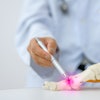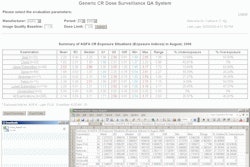A three-year effort to optimize quality control (QC) at seven British Columbia hospitals has identified ways to spare patients from unnecessary radiation exposure during computed radiography (CR) exams.
The project, led by John Aldrich, PhD, professor emeritus of radiology at the University of British Columbia, involved radiologists, medical physicists, radiologic technologists, service engineers, and imaging equipment manufacturers. Their collaboration led to a comprehensive survey of equipment performance in 20 CR rooms, which resulted in the optimization of clinical practices at the hospitals and the elimination of a CR equipment design flaw that raised radiation doses.
"We have standardized dose in the hospitals for common radiographic examinations," said Yogesh Thakur, PhD, a medical physicist at the Vancouver Coastal Health Authority. "And we have improved quality control, so we have a stronger belief that our equipment is producing images at the optimum capacity."
Thakur is first author of a study that summarized the project's results and recommendations; it was published online May 6 in the Journal of Digital Imaging.
The project aimed to improve the quality of CR exams performed at seven provincial hospitals in British Columbia that were consolidated into the Vancouver Coastal Health Authority in 2004. The study was designed and implemented with equipment surveys and dose measurements at the sites for three years ending in 2006. The names of the hospitals and makes and models of the CR equipment involved in the study were not disclosed.
Though individual CR procedures expose patients to very low levels of ionizing radiation, patients can accumulate a substantial exposure from the modality over time if they receive many exams. Radiography accounted for 70% of the procedures involving ionizing radiation at Vancouver General Hospital in 2009, the study noted.
The survey of CR protocols and equipment performance led Aldrich, Thakur, and colleagues to adopt four primary tactics for reducing dose: minimizing automatic exposure control (AEC) imbalances, optimizing bucky preselected protocols, resetting standards for CR, and addressing flawed equipment performance.
AEC imbalances
Automatic exposure control imbalances arise from the inefficient performance of any one or a combination of three chambers in the bucky, Thakur noted. The chambers are designed to shut down when radiation reaches a predefined threshold. Patients are exposed to unnecessary radiation when the x-ray exposure is not terminated correctly. Industry standards tolerate a variation of 20% among the chambers, but the mean AEC imbalance in the study was 37% before the problem was identified and then solved with recalibration.
Bucky preselected protocols
Aldrich and colleagues altered the preselected protocols for all CR buckys to exclusively use left and right AEC cells for chest exams. The new policy capitalized on Aldrich's previous research, which found that using left and right cells led to a mean dose reduction of up to 30% during chest procedures, compared to procedures using the left and center or right and center cells. Equipment performance, including possible AEC imbalance, is now monitored weekly by the health authority's quality control program.
CR standards
The hospitals' frequent use of tube settings that were better suited for plain-film radiography than CR suggested that a radiology department's protocols may not have been modified for CR after its installation. The initial survey found the average setting for CR at the seven hospitals ranged from 100 to 140 kVp for common chest exams.
"CR systems only require 120 kVp potential for chest examinations, so that again reduces dose," Thakur said. "We now have standardized protocols throughout the system."
Equipment performance
The survey found the hospitals were equipped with CR technology from only two manufacturers. One platform exposed patients to doses of radiation that were 60% higher than exposures from the other platform. By collaborating with the vendor, the problem was isolated to the image processing algorithm, and it was corrected in a subsequent software upgrade.
"This highlights the need for end users and manufacturers to look at the dosage issue together," Thakur said. "You really need a team effort, especially with the increased complexity of digital radiographic systems."
The human dimension of the enterprise was also emphasized in a strategic plan Aldrich recommended to physicians and physicists attempting similar projects. The need to educate staff about the importance of safe radiation practices and the importance of getting each hospital to agree to fully participate in dose reduction were ranked ahead of technical imperatives, such as setting a target dose that is consistent with AEC balance and adjusting settings when necessary to ensure high image quality.



















